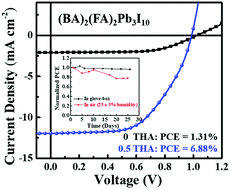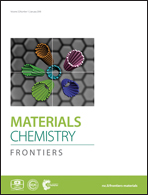Highly oriented two-dimensional formamidinium lead iodide perovskites with a small bandgap of 1.51 eV†
Abstract
Due to the quantum confinement effects, the bandgap of two-dimensional (2D) perovskites increases when the thickness of the inorganic slabs decreases. This could result in insufficient light absorption that limits the overall performance of perovskite solar cells. Here we report a series of small bandgap 2D perovskites using mixed butylammonium (BA) and formamidinium (FA) cations, i.e. (BA)2(FA)n−1PbnI3n+1 (n = 1–5). In particular, 2D perovskite (BA)2(FA)2Pb3I10 shows a small bandgap of 1.51 eV, which is comparable to state-of-the-art three-dimensional perovskites. A strongly preferential out-of-plane crystallographic alignment of the inorganic perovskite component in the (BA)2(FA)2Pb3I10 film is achieved by the addition of thiourea in the precursor. This significantly improves charge transport and thus leads to highly efficient inverted solar cells with a planar structure of ITO/PEDOT:PSS/(BA)2(FA)2Pb3I10/PC61BM/BCP/Ag. With the best power conversion efficiency of 6.88%, we demonstrated the highest PCE reported for FA based low-n (n < 4) 2D perovskite solar cells. By virtue of the stable 2D perovskites, the unencapsulated device retains 80% efficiency after storing in air with a humidity of 25 ± 5% for 25 days, indicating excellent stability against moisture and oxygen.

- This article is part of the themed collections: Celebrating Excellence in Research: Women at the Frontiers of Chemistry and Molecular Materials and Devices


 Please wait while we load your content...
Please wait while we load your content...